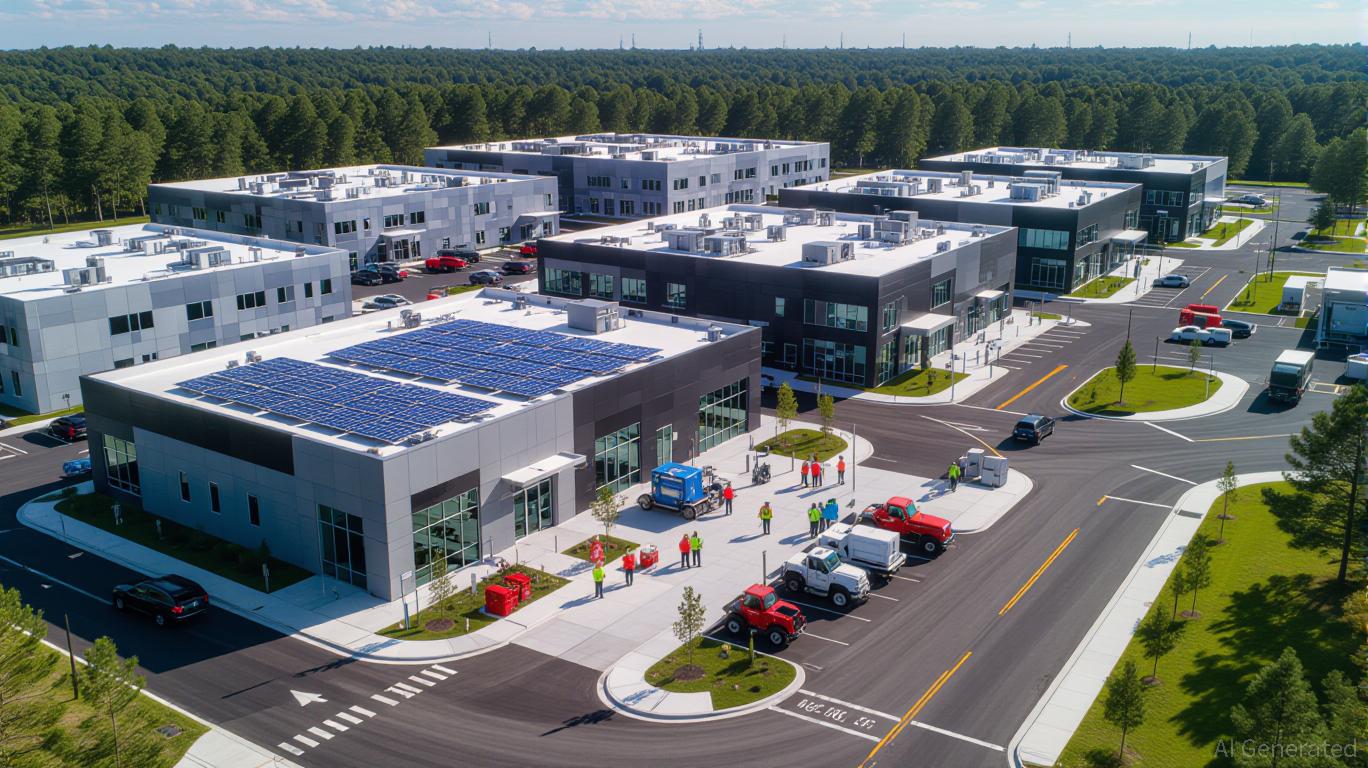Deciphering How Municipal Infrastructure Grants Influence Real Estate Growth and Investment Prospects
- New York's FAST NY program allocated $283M to transform 7,700 acres of industrial land into "shovel-ready" sites for high-tech manufacturing and semiconductors . - Infrastructure upgrades like water/sewer systems directly increased land values by 20% in industrial zones, attracting anchor tenants like Chobani and Micron . - 2025 tax reforms (100% bonus depreciation) amplified private investment, with Q3 2025 real estate deals hitting $310B as manufacturers targeted upgraded sites. - Critics highlight rur
Public Investment and Private Capital: The FAST NY Program’s Impact on Land Value and Development
The relationship between government-funded infrastructure and private sector investment has been fundamental to the growth of cities and industries. New York’s FAST NY Shovel-Ready Grant Program, introduced in 2022, is a prime example of this synergy. By August 2025, the initiative will have distributed more than $283 million over six funding rounds, converting close to 7,700 acres of industrial land into sites ready for immediate development. These locations are now positioned to support advanced manufacturing, logistics, and semiconductor production.
Infrastructure Upgrades Fueling Land Value Growth

Enhancements to infrastructure are a key factor in boosting land values. FAST NY’s Track C grants focus on improving essential systems such as water, sewage, transportation, and energy, addressing obstacles that often deter private investors. For example, the Triangle Site in Oneida County benefited from a $32.36 million grant to expand utilities and roadways, transforming it into a strategic location for companies in the semiconductor supply chain. Similarly, the Hudson River Commerce Park in Greene County received $400,000 to accelerate its readiness for advanced manufacturing operations. These upgrades not only make development less risky for private entities but also increase the attractiveness of these sites to major tenants like Chobani and Micron, whose presence can further drive up land values through clustering effects.
The program’s focus on preparing sites for immediate development reflects broader economic patterns. According to a 2025 Federal Reserve report, infrastructure improvements can raise land values in industrial areas by as much as 20%, as better access and utility capacity reduce costs for businesses. While specific data on FAST NY’s outcomes is not yet available, the program’s strategy of targeting rapidly expanding sectors suggests a strong link between infrastructure spending and rising land values.
Tax Policy Changes and the Surge of Private Investment
Alongside infrastructure grants, recent tax reforms in 2025 have further encouraged private investment. Industry experts highlight that permanent 100% bonus depreciation for qualifying assets and more flexible interest deduction rules have made real estate projects more attractive financially. These provisions enable developers to write off expenses more quickly and lower their debt costs, resulting in higher after-tax profits. For instance, the redevelopment of the Xerox Webster Campus, supported by a $9.8 million FAST NY grant for road and sewer improvements, now offers over a million square feet of industrial space—an appealing prospect for private equity firms seeking lucrative real estate opportunities.
Although detailed figures on private investment in FAST NY sites are limited, broader trends show a significant rise in demand for industrial properties. In the third quarter of 2025, private equity investments in real estate reached a record $310 billion, with logistics and manufacturing centers drawing particular interest. The Oswego County Industrial Park, which received $8.1 million for electrical and telecom upgrades, has already attracted leasing interest from semiconductor companies, reflecting strong confidence in its future potential.
Real-World Examples: Turning Grants into Development
The effectiveness of the FAST NY program is evident in its ability to foster environments that draw private capital. The Western New York Science & Technology Advanced Manufacturing Park (STAMP) was awarded $56 million for infrastructure, including a new wastewater treatment facility and natural gas lines, to support clean technology and semiconductor manufacturing. This investment not only made the site more development-ready but also fit into New York’s broader strategy to become a leader in the semiconductor industry, attracting additional federal and state support.
Another notable case is the Port of Albany’s Beacon Island site, which received $32.6 million for infrastructure enhancements. The completion of this project has enabled the port to compete with other regional logistics centers, attracting warehousing and distribution companies that require robust utilities and transport connections. These examples show how municipal grants can bridge the gap between underused land and industries that need top-tier infrastructure.
Wider Impacts and Ongoing Challenges
While FAST NY has significantly improved the readiness of industrial sites, its long-term effectiveness will depend on continued engagement from the private sector. Some critics point out that the program’s focus on large-scale manufacturing may not adequately address the needs of smaller or rural communities that may struggle to take advantage of such grants. Additionally, the lack of publicly available data on land value changes at grant-supported sites makes it difficult to fully assess the program’s economic impact. Nevertheless, the allocation of an additional $100 million in the Governor’s FY26 budget signals a commitment to refining and expanding the program.
Summary
The FAST NY initiative demonstrates how targeted infrastructure investment can stimulate private capital inflows and enhance the value of commercial land. By reducing barriers to development and focusing on high-growth sectors, the program has established a network of sites ready for investment from both domestic and international players. As favorable tax policies and market trends continue to support real estate growth, the partnership between public grants and private investment is set to remain a key driver of New York’s economic progress.
Disclaimer: The content of this article solely reflects the author's opinion and does not represent the platform in any capacity. This article is not intended to serve as a reference for making investment decisions.
You may also like
XRP News Today: Institutional ETFs and Derivatives Indicate a Positive Shift for XRP Above Crucial Support Levels
- XRP rebounds above $2.20 as buyers defend key support, supported by $107.92M in ETF inflows and rising institutional confidence. - Technical analysis highlights a bullish "Staircase to Valhalla" pattern, with $2.26-$2.52 resistance levels and Fibonacci targets signaling potential for $2.69. - Derivatives data shows aggressive long-positioning (OI: $4.11B), with Binance's 2.56 long-short ratio and 57% options OI surge reinforcing bullish momentum. - Institutional ETF conversions (e.g., Grayscale Zcash) an

Why Switzerland's Temporary Halt on Crypto Highlights Worldwide Regulatory Disunity
- Switzerland delays crypto tax data-sharing until 2027, highlighting global regulatory fragmentation amid CARF adoption challenges. - Two-phase approach prioritizes domestic law alignment before reciprocal agreements with key economies like U.S., China, and Saudi Arabia. - 75 CARF signatories progress unevenly, with U.S. and Brazil proposing alternative frameworks, complicating cross-border compliance. - Swiss crypto firms face operational risks during transition, as critics warn of regulatory arbitrage b

Thailand’s Bold No-Crypto-Tax Move: Shaping a Future Southeast Asian Crypto Center
- Thailand imposes 0% capital gains tax on local crypto trading (2025-2029) to boost its digital economy and attract investors. - The policy aligns crypto profits with tax-exempt stock trading, supported by a 2024 Bitcoin ETF and Tourist DigiPay pilot for foreign visitors. - Regulatory caution is evident through biometric data shutdowns and PDPA compliance, balancing innovation with security amid regional competition. - Projected $1B annual economic gains aim to position Thailand as a top Southeast Asian c
The Transformation of Webster, NY: Targeted Property and Infrastructure Initiatives After the Xerox Era
- Webster , NY, secured a $9.8M FAST NY grant to transform the former Xerox campus into a shovel-ready industrial hub, part of Governor Hochul’s upstate revitalization strategy. - Infrastructure upgrades, including road and sewer improvements, aim to attract advanced manufacturing and logistics firms by reducing development risks and costs. - The Xerox campus redevelopment includes mixed-use projects, projected to create 250 jobs and boost property values through residential and commercial integration. - W
